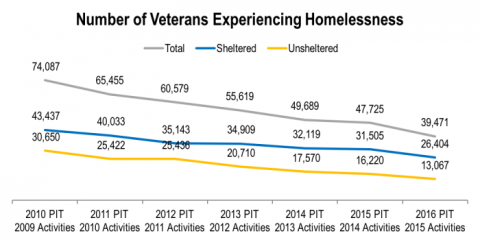- Home
- Agencies
- Department of Agriculture
- Department of Housing and Urban Development
- General Services Administration
- Department of Commerce
- Department of the Interior
- National Aeronautics and Space Administration
- Department of Defense
- Department of Justice
- National Science Foundation
- Department of Education
- Department of Labor
- Office of Personnel Management
- Department of Energy
- Department of State
- Small Business Administration
- Environmental Protection Agency
- Department of Transportation
- Social Security Administration
- Department of Health and Human Services
- Department of the Treasury
- U.S. Agency for International Development
- Department of Homeland Security
- Department of Veterans Affairs
- Goals
- Initiatives
- Programs
Veteran Homelessness Reduced 47% Over 6 Years

The Challenge
In January of 2010, over 74,000 veterans were experiencing homelessness – with more than 30,000 living on the streets. Veterans experience homelessness for many of the same reasons that non-veterans do, including economic and personal hardships and a shortage of affordable housing. However, exposure to combat and repeated deployments may also contribute to homelessness. Veterans have high rates of post-traumatic stress disorder, traumatic brain injury, and sexual trauma that may make it difficult them to find employment and build stable relationships. Multiple and extended deployments may also contribute to unemployment and family conflict that can lead to isolation and homelessness.
The Intervention
Since 2010, HUD, VA, and other Federal partners have expanded the array of services and supports aimed at identifying and rapidly connecting veterans to housing, clinical care, and social services. With new resource investments from Congress, effective interventions — like the HUD-VA Supportive Housing (HUD-VASH) program and the Supportive Services for Veteran Families (SSVF) program — have grown substantially, and have been targeted to areas of greatest need.
In addition to the new targeted resources, agencies are also leveraging mainstream resources to support efforts to end homelessness. For example, HUD is for the first time ever tracking admissions of new homeless households into mainstream HUD-assisted housing (Public Housing, Housing Choice Vouchers, and Multifamily Housing programs) in the Department’s Annual Performance Report.
Underlying these new resources and strategies, a key instrument in improving Federal efforts to end homelessness across all populations has been the adoption of a systems approach. Federal agencies are collaborating across silos, working towards common goals, monitoring and troubleshooting implementation using data and performance management, encouraging investment in evidence-informed practices, and working closely with local community partners.
Performance Management
HUD and the VA have collaborated around a joint Agency Priority Goal to end veteran homelessness in 2015. Leaders from HUD and the VA meet quarterly at “HUDStat” meetings to track progress on reducing veteran homelessness. These quarterly meetings hold programs accountable for their performance and are used to inform program improvements as well as decisions on resource allocation. Resources are directed towards high performing and cost-effective programs and away from underperforming or less cost-effective programs.
Impact
Since 2010, total homelessness among veterans has fallen from over 74,000 to under 40,000 – a 47% improvement. Moreover, the number of homeless veterans who are living on the streets has fallen by 57%.
In addition, a growing list of communities, including the entire states of Connecticut, Delaware, and Virginia, have proven that ending veteran homelessness is possible and sustainable. As documented through the federal Criteria and Benchmarks, they have driven down the number of veterans experiencing homelessness to as close to zero as possible, while also building and sustaining systems that can effectively and efficiently address veterans’ housing crises in the future. A regularly updated list of communities can be found at:





